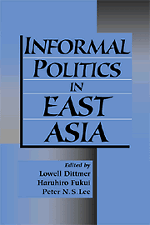Book contents
- Frontmatter
- Contents
- Preface
- Contributors
- INTRODUCTION: On the Significance of Informal Politics
- PART I Informal Politics in Industrialized Asian Democracies
- 1 The Informal Politics of Japanese Diet Elections: Cases and Interpretations
- 2 Informal Politics in Taiwan
- 3 The Election Process and Informal Politics in South Korea
- PART II Dictatorship with Chinese Characteristics: Macroperspectives
- PART III Case Studies in Chinese Corporatism
- PART IV Asian Authoritarianism on the Chinese Periphery
- CONCLUSION: East Asian Informal Politics in Comparative Perspective
- Glossary
- Index
1 - The Informal Politics of Japanese Diet Elections: Cases and Interpretations
Published online by Cambridge University Press: 20 May 2010
- Frontmatter
- Contents
- Preface
- Contributors
- INTRODUCTION: On the Significance of Informal Politics
- PART I Informal Politics in Industrialized Asian Democracies
- 1 The Informal Politics of Japanese Diet Elections: Cases and Interpretations
- 2 Informal Politics in Taiwan
- 3 The Election Process and Informal Politics in South Korea
- PART II Dictatorship with Chinese Characteristics: Macroperspectives
- PART III Case Studies in Chinese Corporatism
- PART IV Asian Authoritarianism on the Chinese Periphery
- CONCLUSION: East Asian Informal Politics in Comparative Perspective
- Glossary
- Index
Summary
As suggested in the Introduction to this volume, informal politics both complements and competes with formal politics in complex and dynamic patterns of interaction. Recent Japanese Diet (parliamentary) elections illustrate this subtle but often powerful role that informal politics plays vis-à-vis formal politics. We examine in this chapter the power and pattern of informal politics primarily in Diet elections held in the late 1980s and early 1990s under the multiple-seat election district system, known as a single non-transferable vote (SNTV) system, as seen in three candidates' experiences. As we will argue, however, our arguments and conclusions also apply to the more recent Diet elections without any significant modifications.
Before we present the case studies and discuss their implications, it will be helpful to reiterate a cliché about Japanese politics in general and Japanese elections under the SNTV system in particular: They were both very expensive. As we pointed out in our previous discussion of a related topic, a candidate could legally spend only so much – a little less than ¥16 million on average in the 1990 lower house general election – during a legally prescribed campaign period of about two weeks. The amount was not insignificant, but neither was it totally beyond the average adult citizen's reach in a nation with a mean per-capita gross national product (GNP) of nearly ¥3.5 million in 1990. In reality, however, a Liberal Democratic Party (LDP) candidate in a Diet election in the late 1980s and early 1990s typically spent between ¥100 and ¥200 million.
- Type
- Chapter
- Information
- Informal Politics in East Asia , pp. 23 - 41Publisher: Cambridge University PressPrint publication year: 2000

